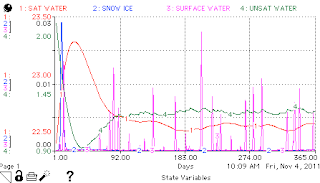Change the model to take into account the growing future demand and therefore a higher future price for the resource. Introduce another parameter which will describe the growing demand for the resource. Make the price a function of both demand and supply. How does this change the results of optimization? Does the discounting still play an important role?
I assumed demand growth independent of supply or price according to the equation
demand = .5*exp(0.15*TIME)
I incorporated demand into price by changing the price function to
price = a*demand/(1 + mining) + b
The major effect on optimization was to increase the value of d from 2.36 to 3.01, which represents more rapid changes in rate of mining.
Discounting plays a more important role than without the growth in demand. The following table summarizes the effects of demand growth and discounting.
Total profits
| Discount rate: | 0% | 5% |
| No demand function | $105k | $66k |
| Growing demand | $699k | $68k |
Exhaustion of resource. Time to exhaustion or, if no exhaustion, resource remaining after 50 years
| Discount rate: | 0% | 5% |
| No demand function | after 50y, 2.7 remain | 20.7y |
| Growing demand | after 50y, 80 remain | 20.2y |
Discounting clearly drives much faster extraction of the resource, and, at least as I formulated the demand function, growing demand has little consequence in a 5% discount rate world -- the urgency of getting the resource to market to be able to take advantage of the discount rate seems to dominate the system.









